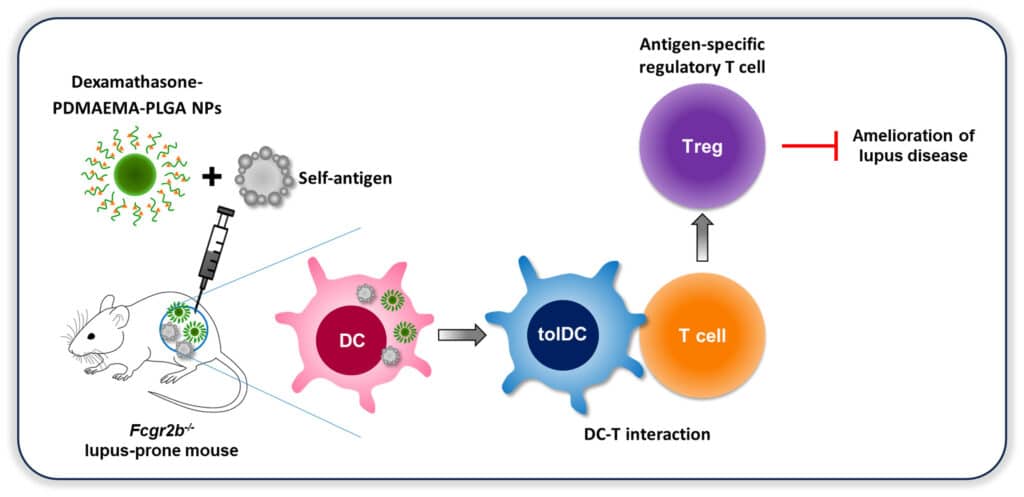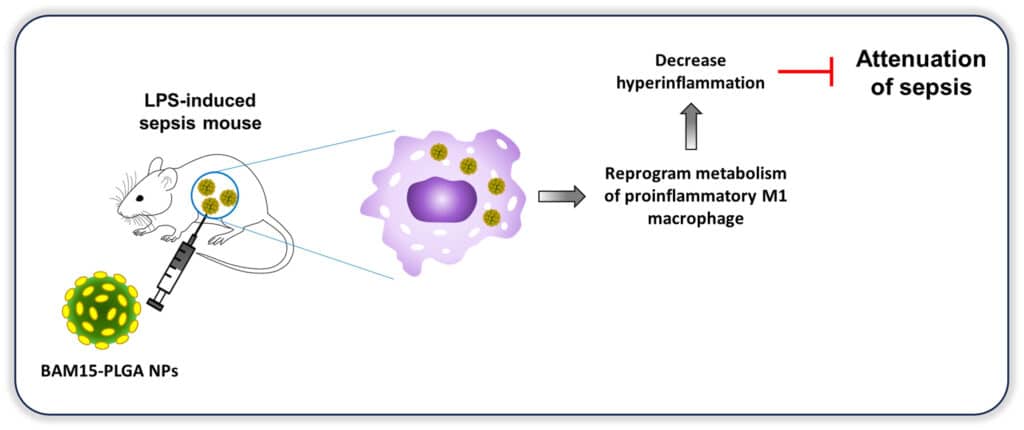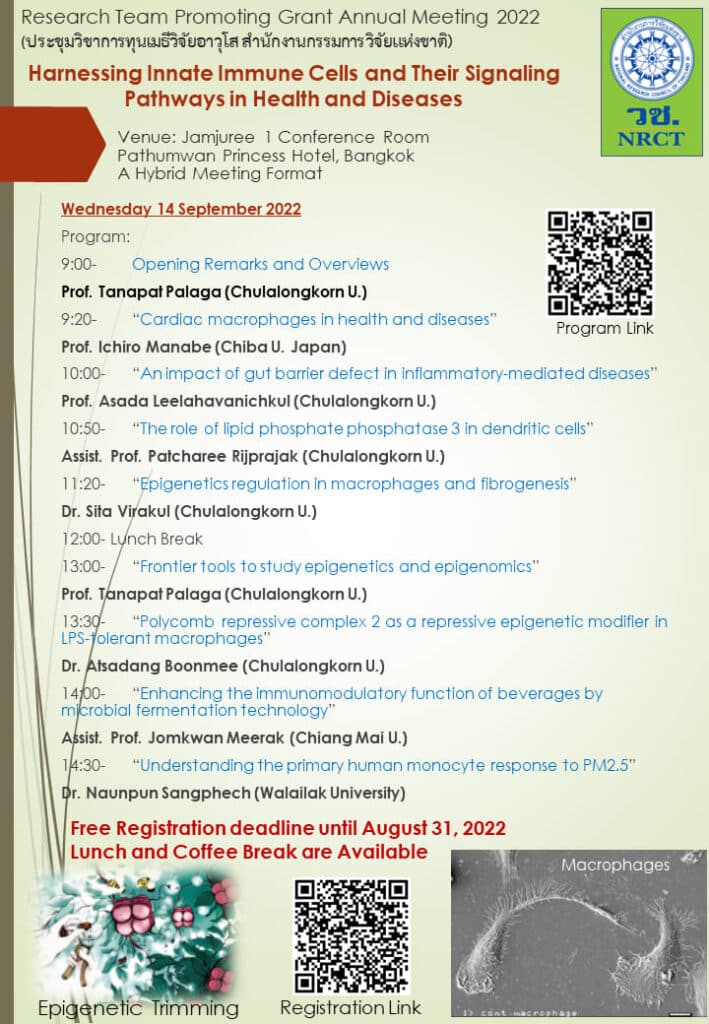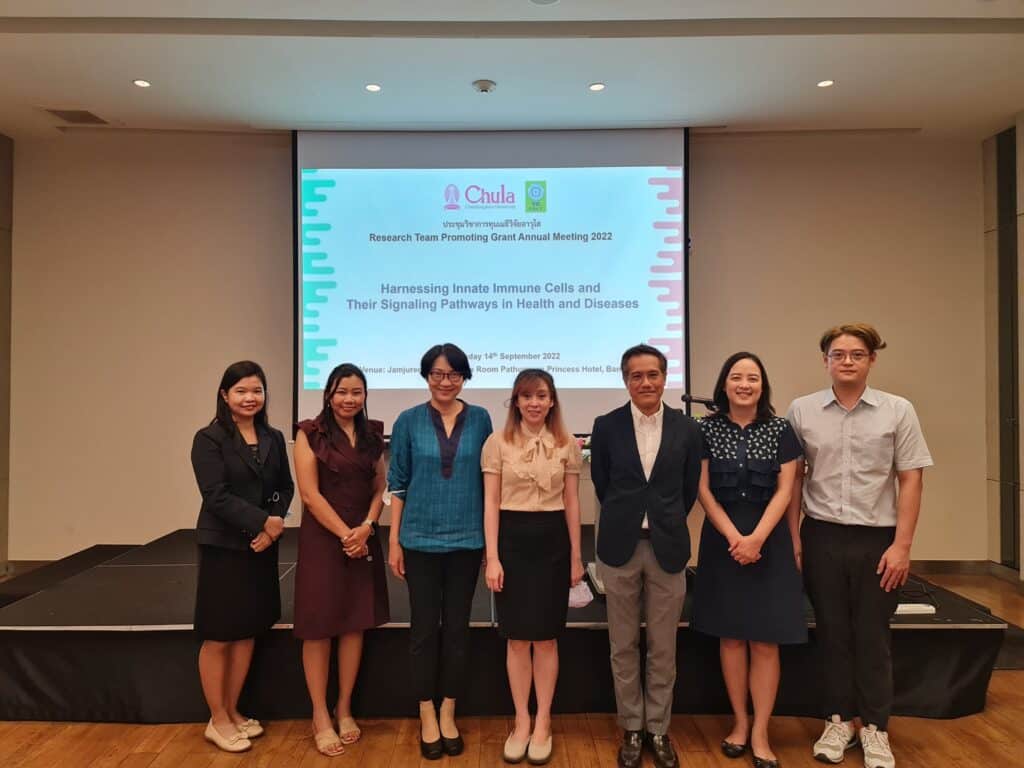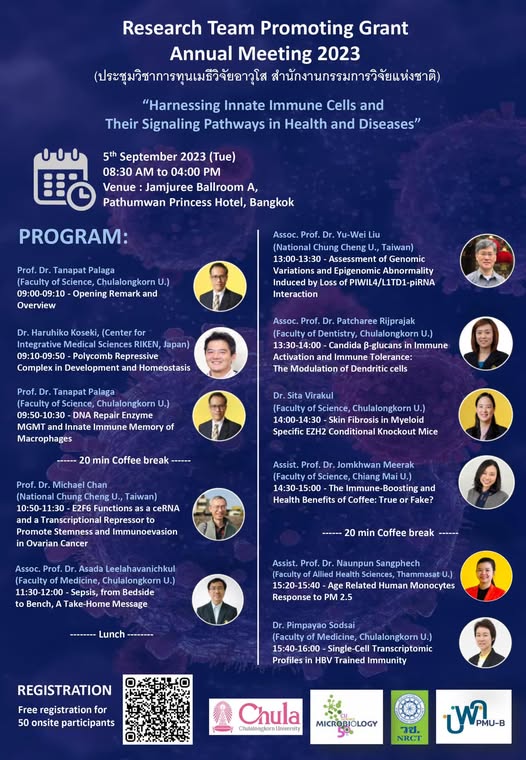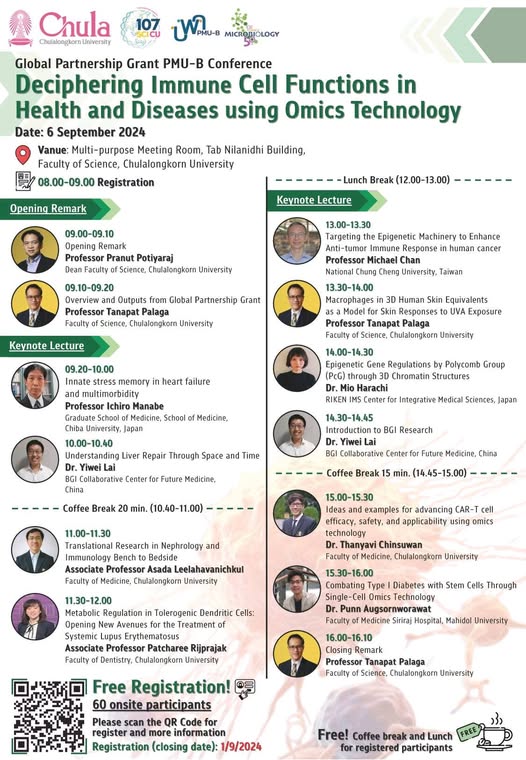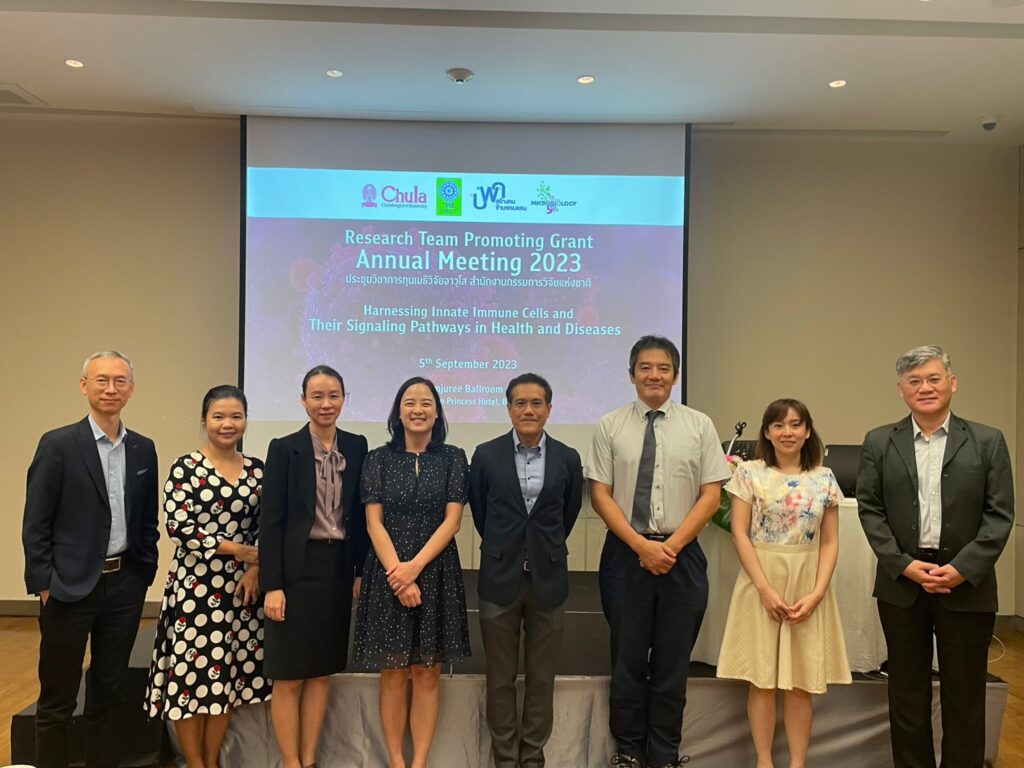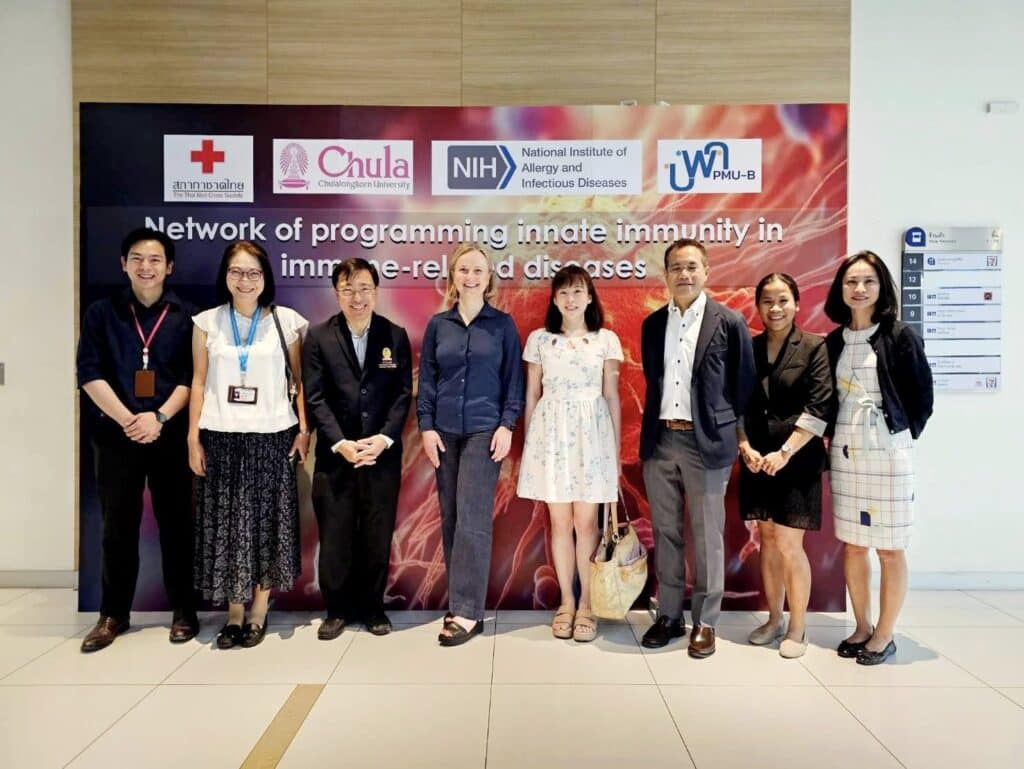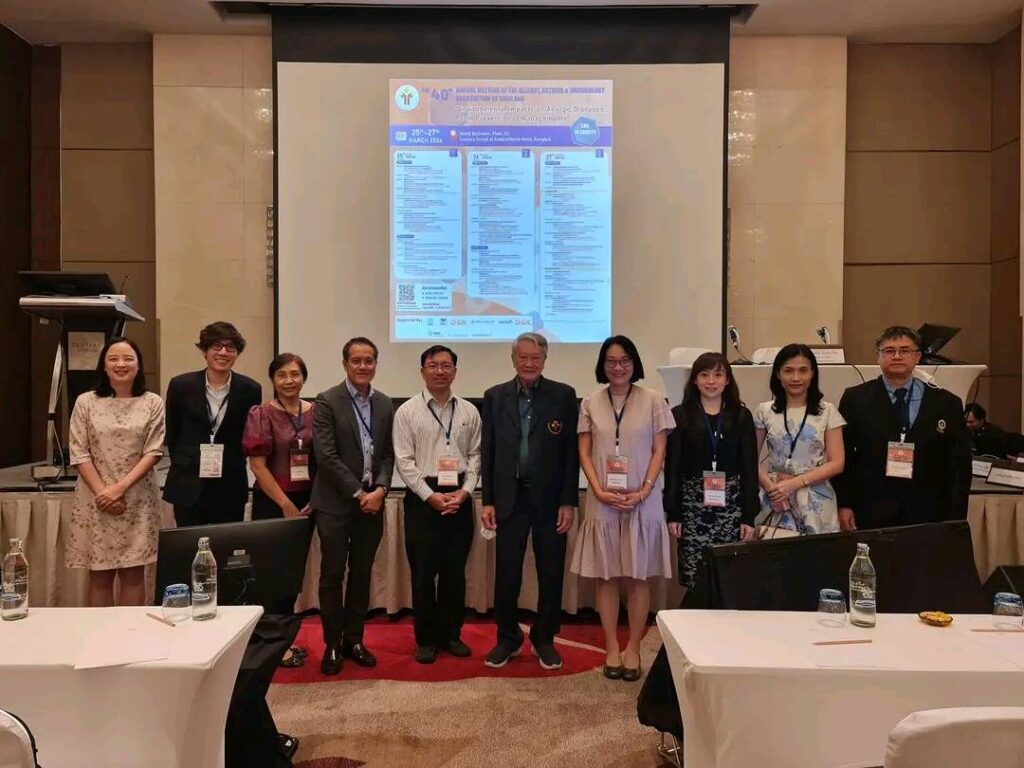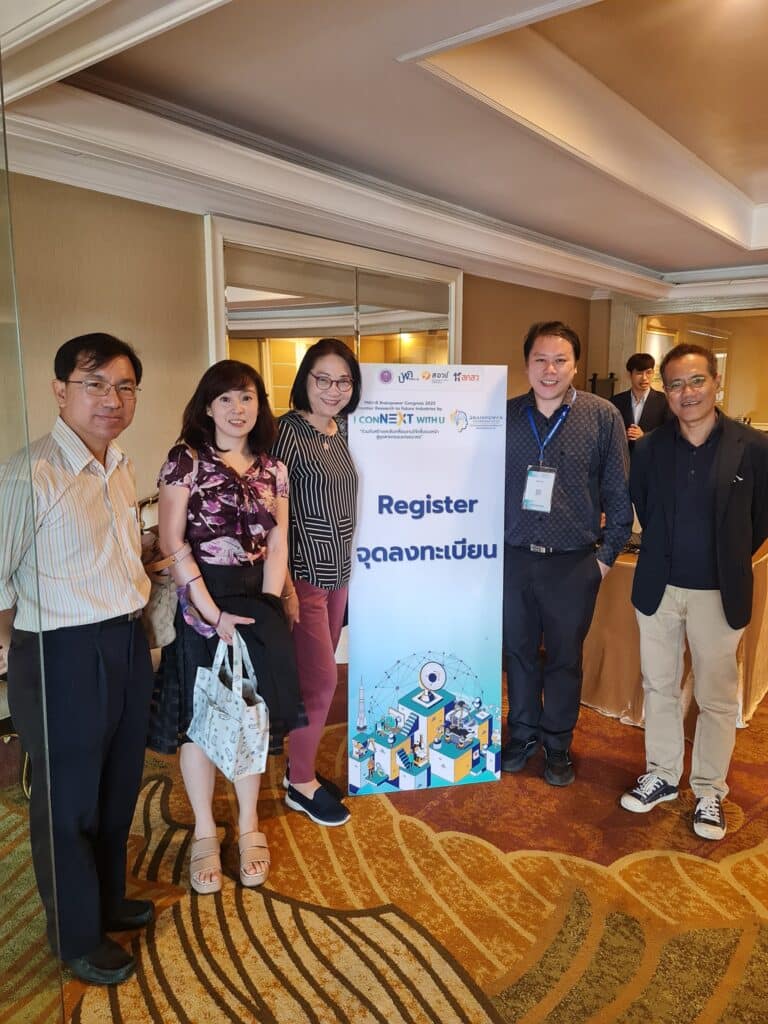รศ.ทพญ.ดร.พัชรี ฤทธิ์ประจักษ์
Assoc. Prof. Patcharee Ritprajak
D.D.S., Ph.D.
อาจารย์ประจำภาควิชาจุลชีววิทยา
Department
มีผลงานวิจัยที่โดดเด่นในด้านชีววิทยาภูมิคุ้มกันของเดนไดรติกเซลล์ (Dendritic cells) โดยมุ่งเน้นการศึกษากลไกทางโมเลกุลของเซลล์เดนไดรต์ที่มีผลต่อโรคในมนุษย์ และการนำความรู้นี้ไปใช้ในการป้องกันและรักษาโรคที่เกี่ยวข้องกับระบบภูมิคุ้มกัน เช่น ภาวะติดเชื้อในกระแสเลือด โรคภูมิต้านตนเอง และมะเร็ง
Research Profile
รองศาสตราจารย์ ทันตแพทย์หญิง ดร.พัชรี ฤทธิ์ประจักษ์ ภาควิชาจุลชีววิทยา คณะทันตแพทยศาสตร์ จุฬาลงกรณ์มหาวิทยาลัย มีผลงานวิจัยที่โดดเด่นในด้านชีววิทยาภูมิคุ้มกันของเดนไดรติกเซลล์ (Dendritic cells) โดยมุ่งเน้นการศึกษากลไกทางโมเลกุลของเซลล์เดนไดรต์ที่มีผลต่อโรคในมนุษย์ และการนำความรู้นี้ไปใช้ในการป้องกันและรักษาโรคที่เกี่ยวข้องกับระบบภูมิคุ้มกัน เช่น ภาวะติดเชื้อในกระแสเลือด โรคภูมิต้านตนเอง และมะเร็ง
ผลงานวิจัยที่สำคัญ คือ การพัฒนาการรักษาด้วยภูมิคุ้มกันบำบัดที่มุ่งเป้าไปยังเดนไดรติกเซลล์ โดยมุ่งเน้นการสร้างและปรับแต่งเดนไดรติกเซลล์ในหลอดทดลอง เพื่อให้มีคุณสมบัติที่เหมาะสมต่อการรักษา นอกจากนี้ ยังมีการพัฒนาแนวทางการให้ยาหรือโมเลกุลที่สามารถปรับเปลี่ยนการทำงานของเดนไดรติกเซลล์ภายในร่างกาย เพื่อเพิ่มประสิทธิภาพในการรักษาแบบการแพทย์เฉพาะบุคคล ซึ่งช่วยให้การรักษามีความแม่นยำและเหมาะสมกับผู้ป่วยแต่ละรายมากยิ่งขึ้น
โครงการวิจัยที่กำลังดำเนินการ
- นวัตกรรมการปรับเปลี่ยนกระบวนการเมตาบอลิซึมของเซลล์เดนไดรติกและแมคโครฟาจ เพื่อประยุกต์ใช้ในการรักษามะเร็งด้วยภูมิคุ้มกันบำบัดและการบำบัดโรคอ้วน
- โครงการนี้ศึกษาวิธีการใหม่ในการปรับเปลี่ยนเส้นทางเมตาบอลิซึมของเซลล์เดนไดรติกและแมคโครฟาจ เพื่อเพิ่มประสิทธิภาพในการควบคุมภูมิคุ้มกัน โดยมีเป้าหมายในการพัฒนาแนวทางการรักษาที่มีประสิทธิภาพมากขึ้นสำหรับภูมิคุ้มกันบำบัดโรคมะเร็ง และ การรักษาโรคอ้วน ผ่านการควบคุมระบบภูมิคุ้มกัน
- การแทรกแซงผ่านเซลล์ภูมิคุ้มกันโดยกำเนิดสำหรับการป้องกันและรักษาเพื่อสุขภาวะ
- โครงการวิจัยนี้มุ่งศึกษาบทบาทของเซลล์ภูมิคุ้มกันโดยกำเนิด โดยเฉพาะเซลล์เดนไดรติก ในการป้องกันและรักษาโรค โดยมีเป้าหมายในการพัฒนาแนวทางการรักษาที่อาศัยระบบภูมิคุ้มกัน เพื่อเสริมสร้างสุขภาพและความเป็นอยู่ที่ดีในระยะยาว
- การควบคุมเมตาบอลิซึมและหน้าที่ทางชีวภาพของเดนไดรติกเซลล์จากหนูลูปัสที่ไม่มีการแสดงออกของยีนเอฟซีแกมม่าอาร์ทูบี
- โครงการนี้ศึกษาว่าการขาด Fc gamma receptor IIB (FcγRIIb) ส่งผลต่อกระบวนการเมตาบอลิซึมและการทำงานของเซลล์เดนไดรติกในหนูลูปัสอย่างไร ซึ่งอาจนำไปสู่ความเข้าใจเชิงลึกเกี่ยวกับกลไกของโรคภูมิต้านตนเอง และแนวทางใหม่ในการรักษาโรคลูปัส
Research of interests
Dendritic cells are a diverse group of specialized antigen-presenting cells that have the bidirectional ability to initiate and dictate immunity toward immune activation and immune tolerance. Immunogenic dendritic cells, which are primarily induced by pathogens and inflammatory mediators, typically promote the effector function of adaptive immune cells. On the other hand, tolerogenic DCs, which are induced by either anti-inflammatory mediators or signals that interfere with immunogenic dendritic cell function, play a critical role in induction of immune tolerance, resolution of ongoing immune responses, and prevention of autoimmunity by inhibiting effector and autoreactive T cells, and by triggering regulatory T cell development. The major advantages of dendritic cells are their ability to induce antigen-specific immunity that presumably is less adverse effect, and their potential to mediate the memory response that helps to prevent the disease recurrence. Therefore, improvement of DC properties is promising, but challenges remain. Our laboratory studies dendritic cell immunobiology and aims to harness dendritic cells ex vivo and in situ to treat immune-related diseases, including sepsis, autoimmune diseases, and cancer. Research in the Ritprajak laboratory determines the molecular mechanisms of dendritic cells that contribute to human diseases and exploits our discovery for the prevention and treatment of immune-related diseases.
Publications
First and corresponding author
- Khiewkamrop P, Kaewraemruaen C, Manipuntee C, Saengruengrit C, Insin N, Leelahavanichkul A, Kaewduangduen W, Sonpoung O, Ariya-anandech K, Hirankarn N, Ritprajak P. Immunosuppressive Polymeric Nanoparticles Targeting Dendritic Cells Alleviate Lupus Disease in Fcgr2b-/- Mice by Mediating Antigen-Specific Immune Tolerance. International Journal of Molecular Sciences. 2023;24(9).
- Vu CTB, Thammahong A, Leelahavanichkul A, Ritprajak P. Alteration of macrophage immune phenotype in a murine sepsis model is associated with susceptibility to secondary fungal infection. Asian Pacific Journal of Allergy and Immunology. 2022;40(2):163-72.
- Saengruengrit C, Rodponthukwaji K, Sucharitakul J, Tummamunkong P, Palaga T, Ritprajak P, Insin N. Effective gene delivery into primary dendritic cells using synthesized PDMAEMA-iron oxide nanocubes. Materials Today Chemistry. 2021;20.
- Rodponthukwaji K, Saengruengrit C, Tummamunkong P, Leelahavanichakul A, Ritprajak P, Insin N. Facile synthesis of magnetic silica-mannan nanocomposites for enhancement in internalization and immune response of dendritic cells. Materials Today Chemistry. 2021;20.
- Ritprajak P, Sirithanakorn C, Nguyen TNY, Sereemaspun A, Aramwit P. Biosynthetic sericin 1-like protein skews dendritic cells to tolerogenic-like phenotype. Biotechnology and Applied Biochemistry. 2021;68(6):1508-17.
- Dinh TTH, Tummamunkong P, Padungros P, Ponpakdee P, Boonprakong L, Saisorn W, Leelahavanichkul A, Kueanjinda P, Ritprajak P. Interaction Between Dendritic Cells and Candida krusei β-Glucan Partially Depends on Dectin-1 and It Promotes High IL-10 Production by T Cells. Frontiers in Cellular and Infection Microbiology. 2021;10.
- Vu CTB, Thammahong A, Yagita H, Azuma M, Hirankarn N, Ritprajak P, Leelahavanichkul A. Blockade of PD-1 Attenuated Postsepsis Aspergillosis Via the Activation of IFN-γ and the Dampening of IL-10. Shock. 2020;53(4):514-24.
- Kaewraemruaen C, Ritprajak P, Hirankarn N. Dendritic cells as key players in systemic lupus erythematosus. Asian Pacific Journal of Allergy and Immunology. 2020;38(4):225-32.
- Ritprajak P, Kaewraemruaen C, Hirankarn N. Current paradigms of tolerogenic dendritic cells and clinical implications for systemic lupus erythematosus. Cells. 2019;8(10).
- Charoenpong H, Osathanon T, Pavasant P, Limjeerajarus N, Keawprachum B, Limjeerajarus CN, Cheewinthamrongrod V, Palaga T, Lertchirakarn V, Ritprajak P. Mechanical stress induced S100A7 expression in human dental pulp cells to augment osteoclast differentiation. Oral Diseases. 2019;25(3):812-21.
- Saengruengrit C, Ritprajak P, Wanichwecharungruang S, Sharma A, Salvan G, Zahn DRT, Insin N. The combined magnetic field and iron oxide-PLGA composite particles: Effective protein antigen delivery and immune stimulation in dendritic cells. Journal of Colloid and Interface Science. 2018;520:101-11.
- Nguyen TNY, Padungros P, Wongsrisupphakul P, Sa-Ard-Iam N, Mahanonda R, Matangkasombut O, Choo MK, Ritprajak P. Cell wall mannan of Candida krusei mediates dendritic cell apoptosis and orchestrates Th17 polarization via TLR-2/MyD88-dependent pathway. Scientific Reports. 2018;8(1).
- Nguyen TNY, Matangkasombut O, Ritprajak P. Differential dendritic cell responses to cell wall mannan of Candida albicans, Candida parapsilosis, and Candida dubliniensis. Journal of Oral Science. 2018;60(4):557-66.
- Nedumpun T, Ritprajak P, Suradhat S. Generation of potent porcine monocyte-derived dendritic cells (MoDCs) by modified culture protocol. Veterinary Immunology and Immunopathology. 2016;182:63-8.
- Ritprajak P, Azuma M. Intrinsic and extrinsic control of expression of the immunoregulatory molecule PD-L1 in epithelial cells and squamous cell carcinoma. Oral Oncology. 2015;51(3):221-8.
- Ritprajak P, Hayakawa M, Sano Y, Otsu K, Park JM. Cell type-specific targeting dissociates the therapeutic from the adverse effects of protein kinase inhibition in allergic skin disease. Proceedings of the National Academy of Sciences of the United States of America. 2012;109(23):9089-94.
- Ritprajak P, Hashiguchi M, Akiba H, Yagita H, Okumura K, Azuma M. Antibodies against B7-DC with differential binding properties exert opposite effects. Hybridoma. 2012;31(1):40-7.
- Ritprajak P, Hashiguchi M, Azuma M. Topical application of cream-emulsified CD86 siRNA ameliorates allergic skin disease by targeting cutaneous dendritic cells. Molecular Therapy. 2008;16(7):1323-30.
Co-author
- Phuengmaung P, Khiewkamrop P, Makjaroen J, Issara-Amphorn J, Boonmee A, Benjaskulluecha S, Ritprajak P, Nita-Lazar A, Palaga T, Hirankarn N, Leelahavanichkul A. Less Severe Sepsis in Cecal Ligation and Puncture Models with and without Lipopolysaccharide in Mice with Conditional Ezh2-Deleted Macrophages (LysM-Cre System). International Journal of Molecular Sciences. 2023;24(10).
- Bulanawichit W, Nguyen TNY, Ritprajak P, Nowwarote N, Osathanon T. Cell Wall Mannan of Candida Attenuates Osteogenic Differentiation by Human Dental Pulp Cells. Journal of Endodontics. 2023;49(2):190-7.
- Udompornpitak K, Charoensappakit A, Sae-Khow K, Bhunyakarnjanarat T, Dang CP, Saisorn W, Visitchanakun P, Phuengmaung P, Palaga T, Ritprajak P, Tungsanga S, Leelahavanichkul A. Obesity Exacerbates Lupus Activity in Fc Gamma Receptor IIb Deficient Lupus Mice Partly through Saturated Fatty Acid-Induced Gut Barrier Defect and Systemic Inflammation. Journal of Innate Immunity. 2022.
- Kaewduangduen W, Visitchanakun P, Saisorn W, Phawadee A, Manonitnantawat C, Chutimaskul C, Susantitaphong P, Ritprajak P, Somboonna N, Cheibchalard T, Wannigama DL, Kueanjinda P, Leelahavanichkul A. Blood Bacteria-Free DNA in Septic Mice Enhances LPS-Induced Inflammation in Mice through Macrophage Response. International Journal of Molecular Sciences. 2022;23(3).
- Hiengrach P, Visitchanakun P, Tongchairawewat P, Tangsirisatian P, Jungteerapanich T, Ritprajak P, Wannigama DL, Tangtanatakul P, Leelahavanichkul A. Sepsis Encephalopathy Is Partly Mediated by miR370-3p-Induced Mitochondrial Injury but Attenuated by BAM15 in Cecal Ligation and Puncture Sepsis Male Mice. International Journal of Molecular Sciences. 2022;23(10).
- Visitchanakun P, Kaewduangduen W, Chareonsappakit A, Susantitaphong P, Pisitkun P, Ritprajak P, Townamchai N, Leelahavanichkul A. Interference on cytosolic DNA activation attenuates sepsis severity: Experiments on cyclic GMP–AMP synthase (cGAS) deficient mice. International Journal of Molecular Sciences. 2021;22(21).
- Charoenpong H, Ritprajak P. Effect of metal ions released from orthodontic mini-implants on osteoclastogenesis. Dental and Medical Problems. 2021;58(3):327-33.
- Jaroonwitchawan T, Visitchanakun P, Dang PC, Ritprajak P, Palaga T, Leelahavanichkul A. Dysregulation of Lipid Metabolism in Macrophages Is Responsible for Severe Endotoxin Tolerance in FcgRIIB-Deficient Lupus Mice. Frontiers in Immunology. 2020;11.
- Taratummarat S, Sangphech N, Vu CTB, Palaga T, Ondee T, Surawut S, Sereemaspun A, Ritprajak P, Leelahavanichkul A. Gold nanoparticles attenuates bacterial sepsis in cecal ligation and puncture mouse model through the induction of M2 macrophage polarization. BMC Microbiology. 2018;18(1).
- Chawalitpong S, Chokchaisiri R, Suksamrarn A, Katayama S, Mitani T, Nakamura S, Athamneh AA, Ritprajak P, Leelahavanichkul A, Aeimlapa R, Charoenphandhu N, Palaga T. Cyperenoic acid suppresses osteoclast differentiation and delays bone loss in a senile osteoporosis mouse model by inhibiting non-canonical NF-κB pathway. Scientific Reports. 2018;8(1).
- Amornwachirabodee K, Tantimekin N, Pan-In P, Palaga T, Pienpinijtham P, Pipattanaboon C, Sukmanee T, Ritprajak P, Charoenpat P, Pitaksajjakul P, Ramasoota P, Wanichwecharungruang S. Oxidized Carbon Black: Preparation, Characterization and Application in Antibody Delivery across Cell Membrane. Scientific Reports. 2018;8(1).
- Nedumpun T, Wongyanin P, Sirisereewan C, Ritprajak P, Palaga T, Thanawongnuwech R, Suradhat S. Interleukin-1 receptor antagonist: An early immunomodulatory cytokine induced by porcine reproductive and respiratory syndrome virus. Journal of General Virology. 2017;98(1):77-88.
- Injumpa W, Ritprajak P, Insin N. Size-dependent cytotoxicity and inflammatory responses of PEGylated silica-iron oxide nanocomposite size series. Journal of Magnetism and Magnetic Materials. 2017;427:60-6.
- Hayakawa M, Hayakawa H, Petrova T, Ritprajak P, Sutavani RV, Jiménez-Andrade GY, Sano Y, Choo MK, Seavitt J, Venigalla RKC, Otsu K, Georgopoulos K, Arthur JSC, Park JM. Loss of functionally redundant p38 isoforms in T cells enhances regulatory T cell induction. Journal of Biological Chemistry. 2017;292(5):1762-72.
- Ajkidkarn P, Ritprajak P, Injumpa W, Porntaveetus T, Insin N. Synthesis, characterization, drug release and transdentinal delivery studies of magnetic nanocubes coated with biodegradable poly(2-(dimethyl amino)ethyl methacrylate). Journal of Magnetism and Magnetic Materials. 2017;427:235-40.
- Manokawinchoke J, Ritprajak P, Osathanon T, Pavasant P. Estradiol induces osteoprotegerin expression by human dental pulp cells. Odontology. 2016;104(1):10-8.
- Osathanon T, Ritprajak P, Nowwarote N, Manokawinchoke J, Giachelli C, Pavasant P. Surface-bound orientated Jagged-1 enhances osteogenic differentiation of human periodontal ligament-derived mesenchymal stem cells. Journal of Biomedical Materials Research – Part A. 2013;101 A(2):358-67.
- Caballero-Franco C, Choo MK, Sano Y, Ritprajak P, Sakurai H, Otsu K, Mizoguchi A, Park JM. Tuning of protein kinase circuitry by p38α is vital for epithelial tissue homeostasis. Journal of Biological Chemistry. 2013;288(33):23788-97.
- Cao Y, Zhang L, Ritprajak P, Tsushima F, Youngnak-Piboonratanakit P, Kamimura Y, Hashiguchi M, Azuma M. Immunoregulatory molecule B7-H1 (CD274) contributes to skin carcinogenesis. Cancer Research. 2011;71(14):4737-41.
- Cao Y, Zhang L, Kamimura Y, Ritprajak P, Hashiguchi M, Hirose S, Azuma M. B7-H1 overexpression regulates epithelial-mesenchymal transition and accelerates carcinogenesis in skin. Cancer Research. 2011;71(4):1235-43.
- Ritprajak P, Hashiguchi M, Tsushima F, Chalermsarp N, Azuma M. Keratinocyte-associated B7-H1 directly regulates cutaneous effector CD8+ T cell responses. Journal of Immunology. 2010;184(9):4918-25.
- Kobori H, Hashiguchi M, Piao J, Kato M, Ritprajak P, Azuma M. Enhancement of effector CD8+ T-cell function by tumour-associated B7-H3 and modulation of its counter-receptor triggering receptor expressed on myeloid cell-like transcript 2 at tumour sites. Immunology. 2010;130(3):363-73.
- Azuma M, Ritprajak P, Hashiguchi M. Topical application of siRNA targeting cutaneous dendritic cells in allergic skin disease. Methods in molecular biology (Clifton, NJ). 2010;623:373-81.
- Hashiguchi M, Kobori H, Ritprajak P, Kamimura Y, Kozono H, Azuma M. Triggering receptor expressed on myeloid cell-like transcript 2 (TLT-2) is a counter-receptor for B7-H3 and enhances T cell responses (Proceeding of the National Academy of Siences of the United States of America (308) 105, (10495-10500) DOI: 10.1073/pnas.0802423105). Proceedings of the National Academy of Sciences of the United States of America. 2008;105(38):14744.


